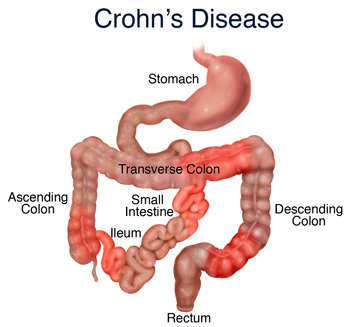Since Crohn’s disease doesn’t have a cure, treating it is a matter of doing three things:
- Relieving the symptoms as much as possible
- Maintaining a healthy body in between flare-ups
- Reducing the pain whenever and however necessary
Today’s research has provided the medical community with the ability to do these things, and often do them very well.
Relieving Symptoms
The most effective way to alleviate the symptoms of Crohn’s is through a carefully constructed series of medications unique to each patient. With so many drugs on the market and each affecting everyone so differently, doctors typically spend a good bit of the early stages of treatment figuring out which medications are right for each of their patients.
From anti-inflammatories to biologoic therapy, there are a number of different ways to ease the discomfort of Crohn’s patients, and each is as individual as the patient. Once the symptoms are under control, a new drug regiment must be determined to keep the patient in a state of remission so as to avoid any further concerns.
Keeping Healthy
Because of the inability to absorb and metabolize many of the nutrients they take in, Crohn’s patients have to work extra hard at staying healthy. This usually includes taking numerous nutritional supplements, as well as making sure to eat even when they may not feel like it.
Another suggestion to maintain a healthy, upbeat outlook is regular exercise. This will help release endorphins into the body that can have a positive affect on all levels of your treatment.
Reducing Pain
While everything is done to avoid surgery, statistics show that up to 75% of Crohn’s patients will eventually need some form of relief through surgery. Whether that is done through a laparoscopic procedure or a full, open abdominal surgery depends entirely on the problems encountered.
The most common type of surgery needed is to alleviate blockages caused by a stricture, or narrowing, of the intestines due to inflammation. Called a strictureplasty, it involves releasing the stricture by making a small incision in the intestines and sewing it crosswise to create a larger passage.
In the case of a severely damaged portion of intestines, a resection may be required. When that is necessary, a portion of the intestines are actually cut out and the healthy portions are reconnected.
Should a fistula form, surgery may be required to disconnect the two organs to allow them to heal separately and to prevent infection through drainage of the intestines into other organs.
And finally, the draining of an abscess can be accomplished through inserting a catheter into the blister to allow it to drain externally until it heals completely.
Remissions
The general goal is to lengthen the time between flare-ups. By relieving the symptoms and maintaining an overall healthy existence, Crohn’s patients can be their own best advocate in staying in remission.
Communication with their doctors will be the key to making that happen. Being open about the affects of their medications – the positive and the negative – as well as paying attention to their bodies and sharing that with their doctors can do more to help treat their disease than anything else.

